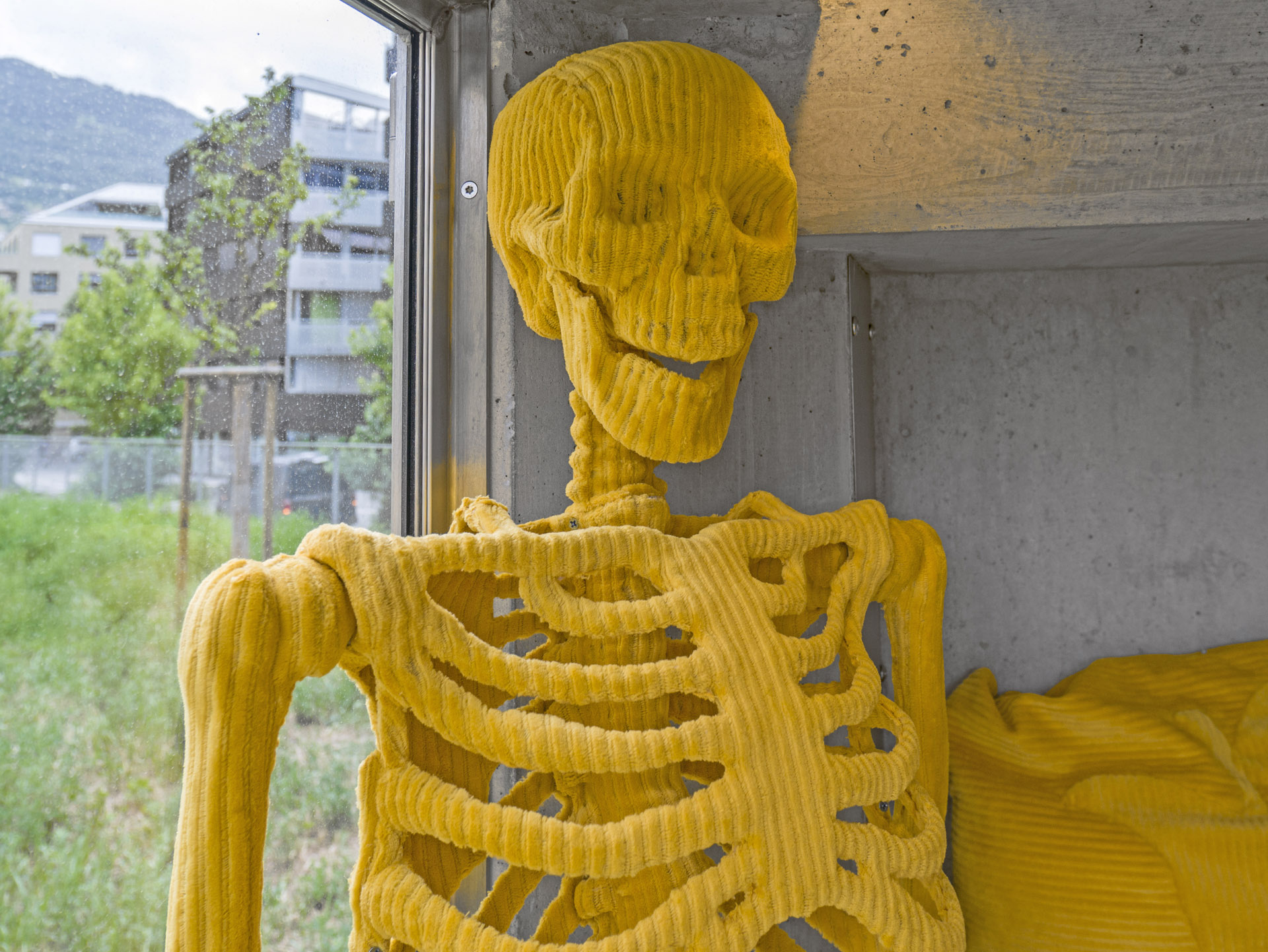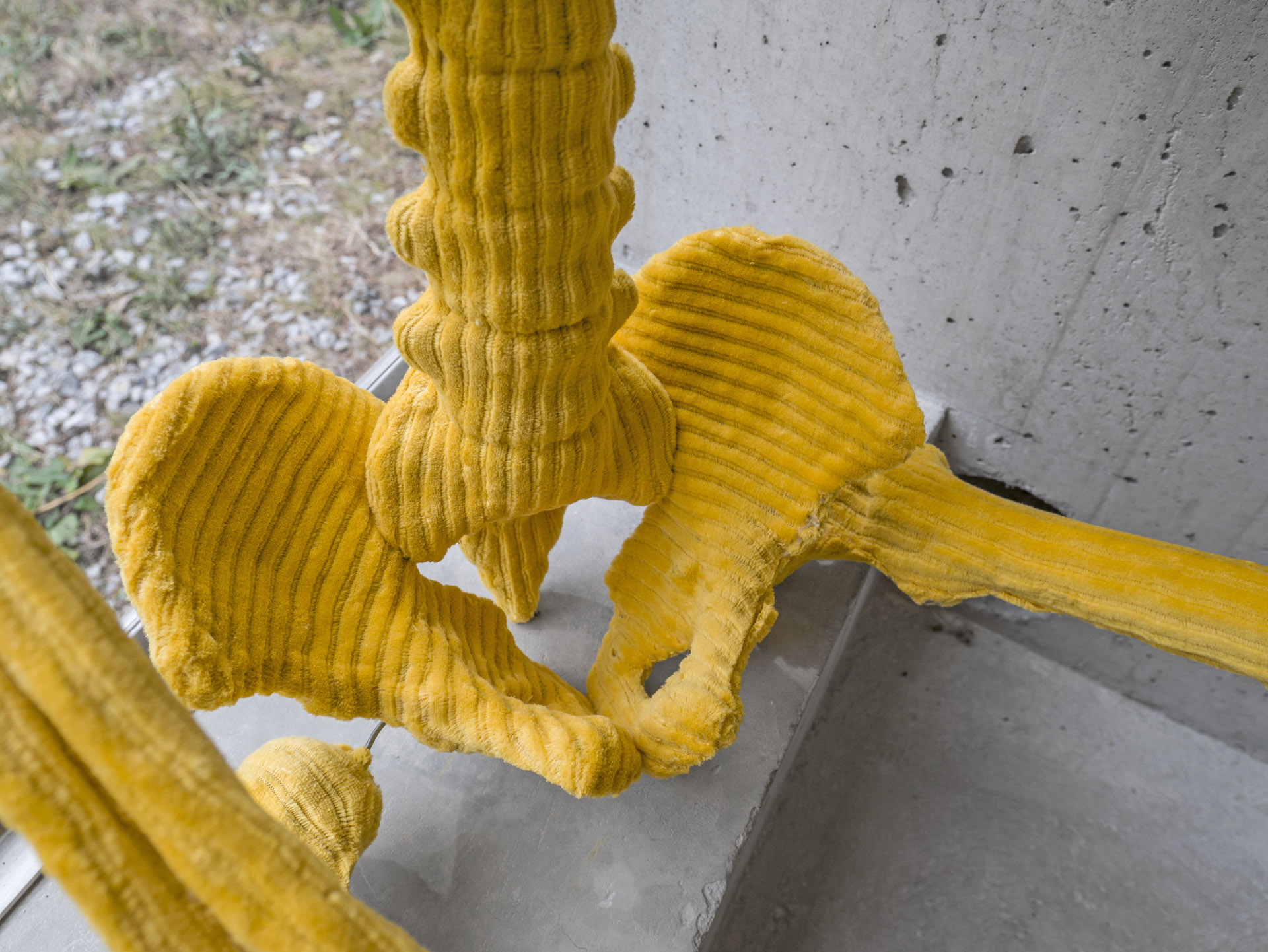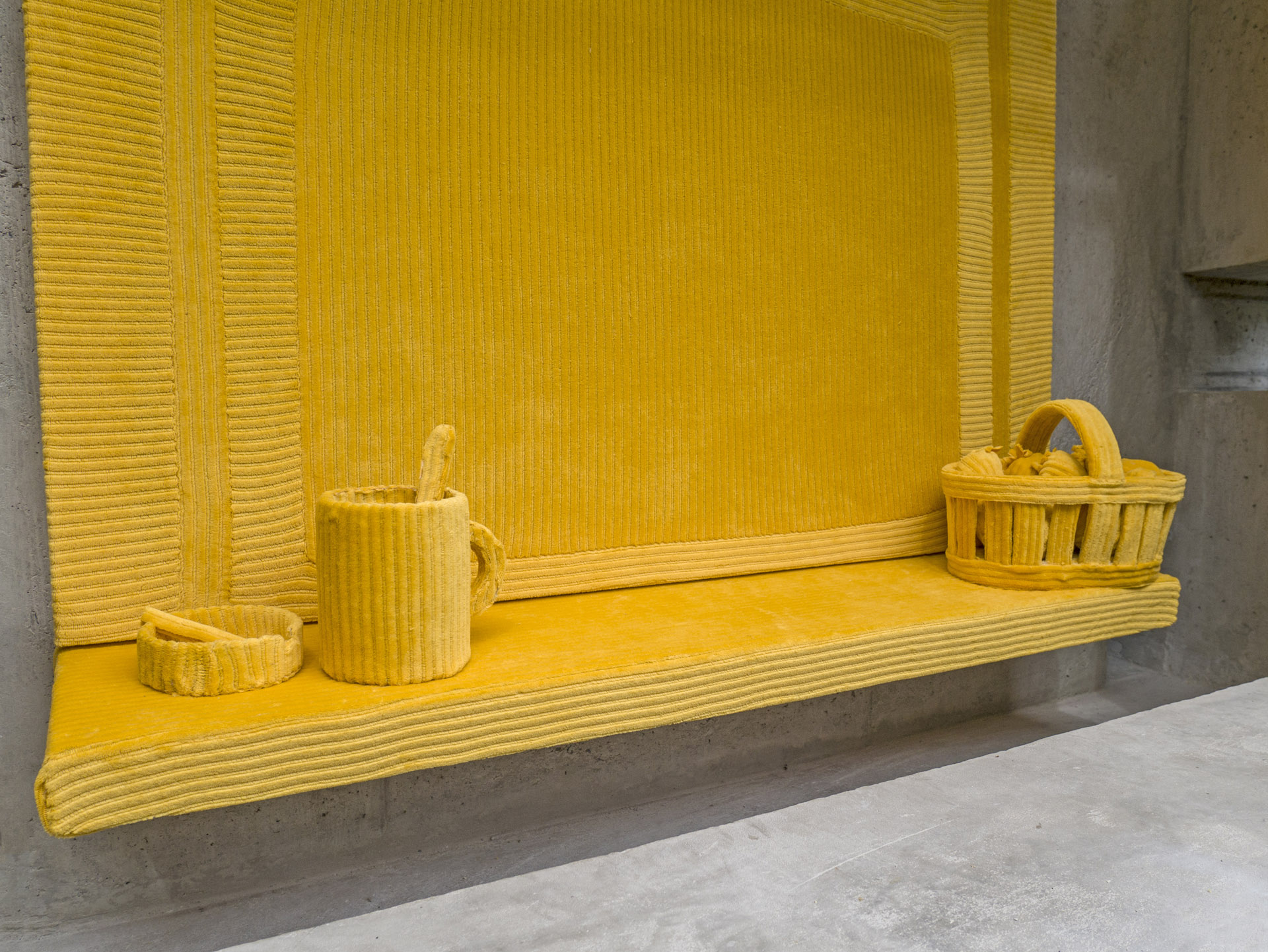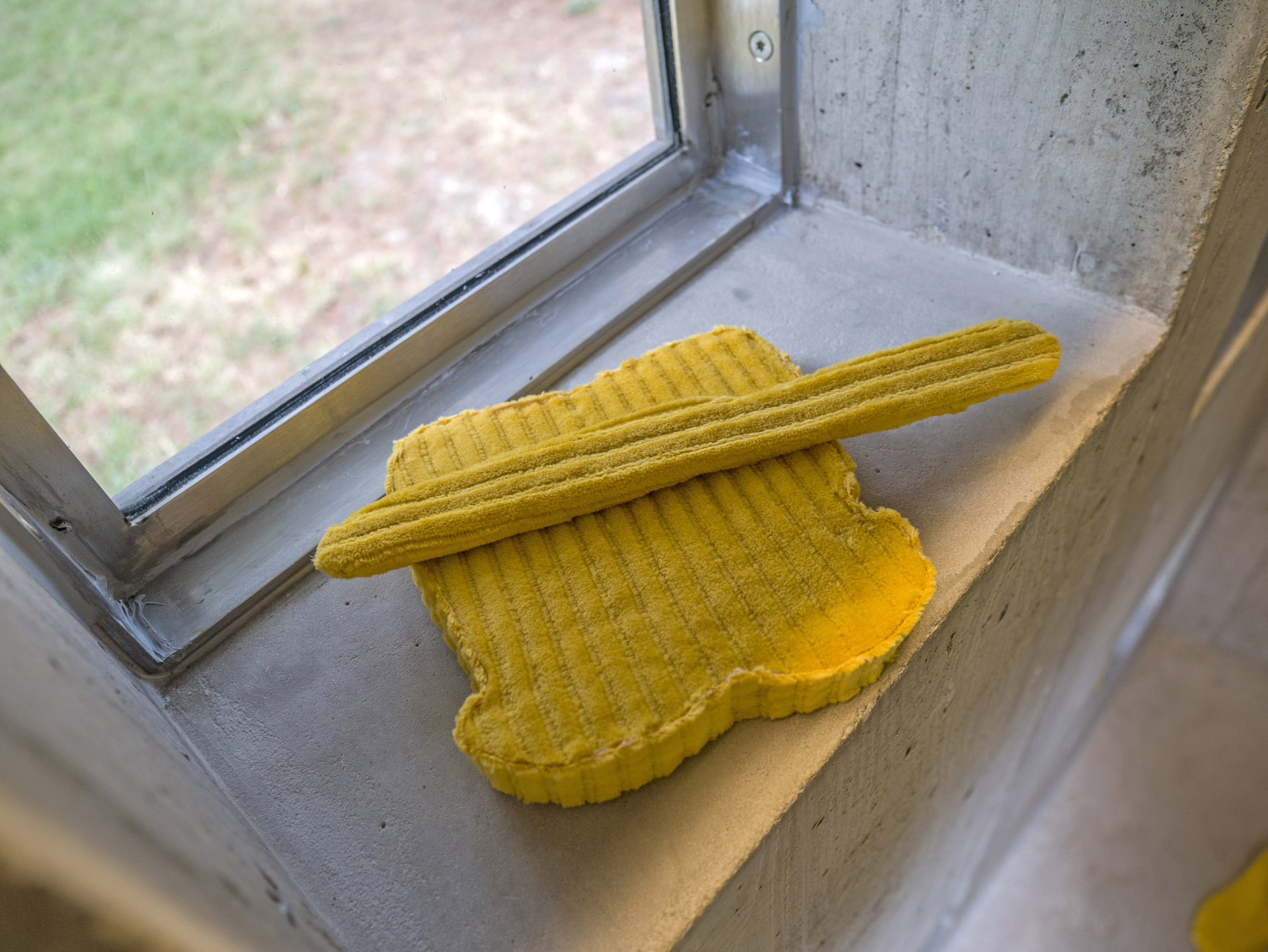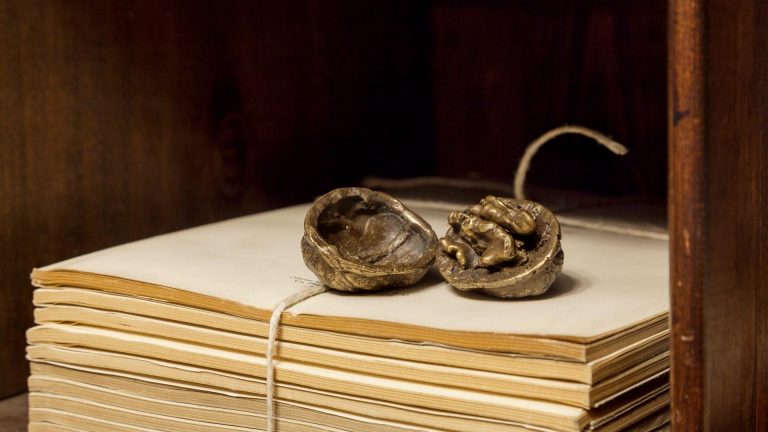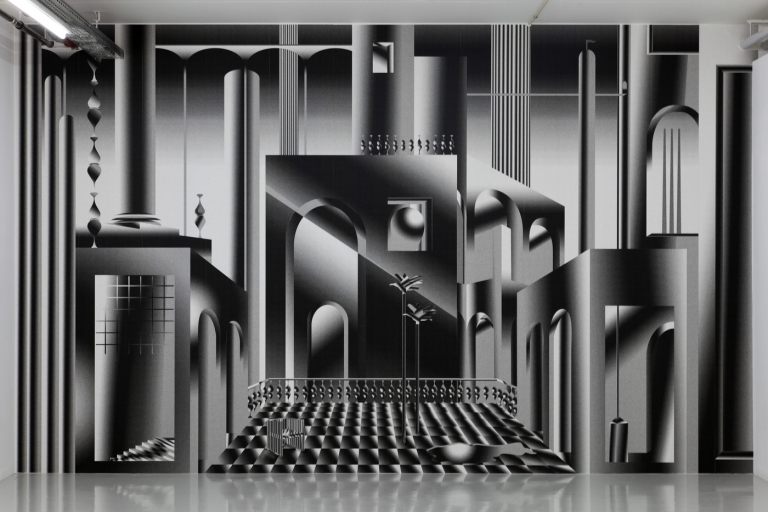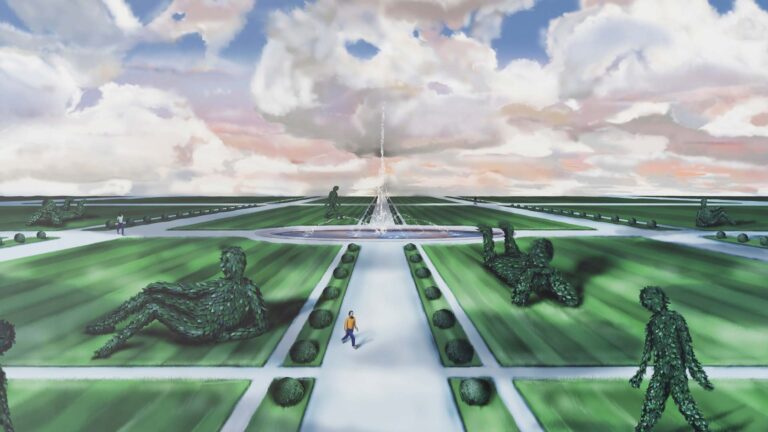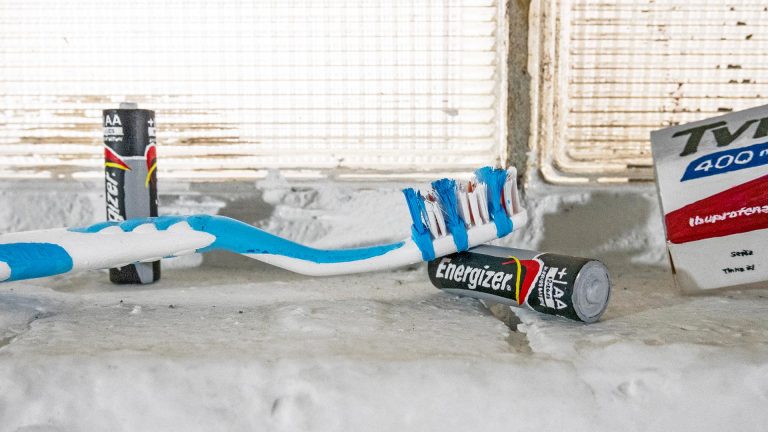Artist: Couple (Adam Cruces & Louisa Gagliardi)
Exhibition title: Fool’s Gold
Curated by: Josiane Imhasly
Venue: Lemme, Sion, Switzerland
Date: May 16 – June 22, 2022
Photography: all images copyright and courtesy of the artist and Lemme, Sion
A World of Corduroy
Fool’s Gold and Ochre Yellow
The title Fool’s Gold that COUPLE (Adam Cruces & Louisa Gagliardi) chose for this exhibition sparked vivid memories of the blissful childhood hours I spent at the Lengenbach mineral mine in the Binn Valley. Surrounded by “fool’s gold” at the mine, I pictured myself in a golden dream world, thanks to the massive deposits of the mineral pyrite. It was an early experience of the seductive power of imagination and deception and of the immersion in an alternative reality.
In COUPLE’s exhibition at Lemme, Fool’s Gold refers to the ochre-yellow colour of the corduroy that covers everything on display: two skeletons, various everyday objects, a pillow, and two wall pieces. As a pigment, fool’s gold – pyrite –has a greyish hue resembling gold in the sunlight and is an unstable mineral (it decomposes in an oxygen-rich and humid atmosphere). Meanwhile, ochre pigments are long-lasting and can be used in a variety of ways. Ochre featured in cosmetics, rituals, and art over 70,000 years ago. Surprisingly thick layers of the pigment have been found on cave floors; people may have used it to paint not only the walls but also their bodies. Pyrite has also been found in caves, where the mineral was used to spark fires. The materials ochre and pyrite could thus have come together during the Stone Age. In the installation Fool’s Gold, they meet through the all-encompassing colour of ochre yellow and the title. Knowing their characteristics is helpful for the analysis of the artwork for three reasons. First, both materials are found all over the planet and have been used by humans since prehistoric times, which points to the universality and timelessness of the installation. Second, as pigments, their properties are antithetical: ochre is durable, but pyrite is not. This aspect suggests the tension between the different parallel times conveyed in Fool’s Gold. The skeletons transport us deep into the past, while the everyday objects surrounding this domestically furnished couple create a connection to today’s world – the number 22 on the shirt even alludes to the current year. The impression this makes is of Lemme as a time capsule. Only the year it represents is unclear: 2022, the 1980s, the late-19th century, or 70,000 years ago? Third, both materials stand for the imagination and illusion, themes that this exhibition also addresses.
Skeletons, everyday objects, pictures
When approaching Lemme, the first thing that catches the eye is that everything on display – the skeletons, everyday objects, and wall pieces – is covered in the same ochre-yellow fabric. This gives the impression that they all spring from the same alternative reality. The soft quality of the corduroy and its ribbed contours are perfect for lending the skeletons a sense of vitality. In the case of the pillow and the two wall pieces, the characteristics of the corduroy are used to generate images. These images are informed by a cultural archive, combining references from art history with universal symbols and pop culture motifs.
Painting is central to the individual artistic practices of both Gagliardi and Cruces and their COUPLE collaboration. So it is not surprising that various allusions to the history of painting can be found in Fool’s Gold. As a whole, the installation can be read as a still life: the skulls of the skeletons, the hidden apple in the reversible figure, the fruit basket, and the sundry breakfast objects (cup, milk carton, piece of toast with knife, even the ashtray with cigarette) are among the frequently used motifs of this genre.
While the corduroy ribs are shifted in direction to produce different images, our perception of the pillow image switches back and forth between an apple and two faces – the profiles of Gagliardi and Cruces. Such ambiguous images were popular at the end of the 19th century. The figure on the pillow is a variation on a well-known motif from that time, which to this day belongs to the standard repertoire used to illustrate perceptual phenomena. COUPLE have replaced Edgar Rubin’s vase with an apple. The apple is an ancient symbol of fertility, sexuality, and temptation, and plays a role in Western art history as the fruit of knowledge, which leads to the Fall and the expulsion of Adam and Eve from Paradise. The pillow image is not only a variation on a familiar type of picture but also a contemporary interpretation of the Adam and Eve complex, the apple also being a nod to the technology giant of the same name. Furthermore, the two profiles inevitably enter into a dialogue with the skeletons – How are they connected? Are they the same as the skeletons?
One of the wall pieces takes up the window motif, which has been popular in painting since the Renaissance. Traditionally, the window opens up an image of the world through an imaginary pictorial space. Since modern times, of course, this theme has been varied and questioned countless times. COUPLE now makes use of the unique visual relationships that Lemme generates to offer a double window view. However, this view is ultimately thwarted: as visitors, we look through a window at the skeleton, which, in turn, looks through a window. But we are unable to recognize what the figure sees – we do not belong to the same corduroy world. Perhaps the movie poster for Stanley Kubrick’s horror film The Shining (1980), which features in the second wall piece, provides a key? The film is set in the Colorado mountains at the historic Overlook Hotel, which Jack Torrance (Jack Nicholson) takes care of with his family during the offseason. His son Danny has the “shining”: the gift of perceiving the supernatural, which in this case means mainly eerie occurrences. COUPLE sees the reference to this film in the claustrophobic confinement of the space and the surrounding mountains. As a setting, the Overlook Hotel simultaneously symbolizes horror (for the winter caretakers) and paradise (for the summer guests). It was inspired by a hotel built in the Rocky Mountains around 1900 that served as a resort and health retreat – as such, it could just as easily be in the Valais. This fact establishes an imaginary connection between the skeletal couple in Lemme and the temporary residents at the hotel in Colorado. Whether the skeletons enjoy the view of a paradisiacal landscape or look horror in the eye remains hidden.
– Josiane Imhasly
The installation was realized with the support of SIGG LABS.




